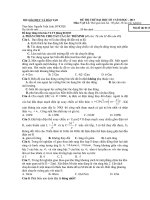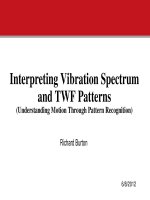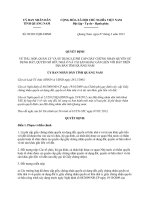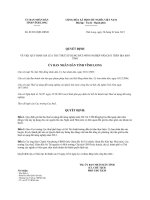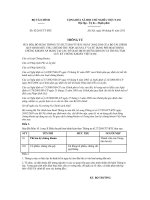PatternRecognition RBurton 02 2013
Bạn đang xem bản rút gọn của tài liệu. Xem và tải ngay bản đầy đủ của tài liệu tại đây (719.22 KB, 46 trang )
Interpreting Vibration Spectrum
and TWF Patterns
(Understanding Motion Through Pattern Recognition)
Richard Burton
6/8/2012
Patterns
• When reduced to it’s most basic concept, Vibration Analysis
can be thought of as looking for ‘Patterns’ in the vibration
data.
• We use the same concepts that we learned in kindergarten:
– Even spacing (harmonics)
– Mirror image (sidebands)
– Comparing objects (baseline, other directions or similar
machine)
– “Odd Man Out” (group comparison)
2
Spectrum Patterns
3
Spectrum Patterns
• There are four basic spectrum patterns:
– Harmonics - Almost always caused by the TWF shape
– Sidebands - Due to Amplitude or Frequency Modulation
– Mounds/Haystacks - Random vibration occurring in a
frequency range
– Raised Noise Floor - White noise or large random events
4
Spectrum Harmonics
•
•
•
•
•
The FFT is breaking down the
TWF into a combination of
sinusoidal frequencies
The only motion that can be
represented by one sine wave
is a sine wave!
For any other shape of motion,
the FFT will ADD harmonics of this motion to the Spectrum
Square or Triangular motion produces odd harmonics, while impactive or spike
motions will produce odd and even harmonics
The harmonics caused by the shape of the motion do not “physically” exist in the
machine. However, since the FFT math needs them to break down the motion, it
removes amplitude from the fundamental to give to the harmonics
5
Spectrum Harmonics
• A sinusoidal motion is usually
due to a force that is smoothly
applied and released or present
continuously
• Squared motion is usually due
to a truncation or rubbing event
• Triangular motion is usually due
to a sliding (slop), binding or rocking motion
• Spikes are usually due to impacting or pulsations (such as air or fluid
pulsations in a pump)
• Since the majority of TWFs are not saved, understanding the
relationship between the harmonic pattern and the motion that
produced it is vital to visualizing the machine motion (problem)
6
Spectrum Subharmonics
• A subharmonic will be generated when the TWF is truncated on one
side, or nonsymmetrical
• Just like harmonics, subharmonics caused by a truncated or
nonsymmetrical TWF do not exist as real motion! They are generated
by the FFT math
–In trying to flatten only one side of the TWF, the FFT requires a sine
wave that is a fraction of the actual motion frequency, and multiples
of this fraction
7
Spectrum Sidebands
• Amplitude Modulation (AM)
– One frequency (carrier) is getting
louder and softer at another
frequency (modulating freq)
– AM is mono. Mono is ‘one’, which
implies one sideband on each side
of the carrier
• Frequency Modulation (FM)
– One frequency (carrier) is speeding
up and slowing down
– FM is stereo. Stereo is ‘more than
one’, which implies more than one
sideband on each side of the carrier
(usually a linear amplitude reduction)
8
Spectrum Sidebands
• Frequencies can have AM sidebands, FM sidebands or both
• Sideband spacing is ‘how often’ the center frequency (called
the carrier) is changing
• Sideband spacing should be matched to a specific
component, whenever possible
– RPM of the applicable shaft
– Bearing Cage
– Etc.
9
Mounds or Haystacks
• Mounds are most commonly due to:
– Resonance amplification
• Both frequencies and the noise floor will be mounded up in a volcano shape
– Looseness
• Low levels of looseness will have the noise floor mounded up in the region
of natural frequencies, even if no discrete frequency is in the region
– Flow induced vibration
• Turbulence or recirculation
• Cavitation (centrifugal pumps only)
– Sidebands with low spectrum resolution
• Frequencies will tend to blur together
• Common example is Ball Spin with Cage sidebands
10
Flow Induced Mounds
• Turbulence or Recirculation
– Turbulent flow due to piping obstructions, nicks, burrs, etc.
– Operating near Shutoff causes high recirculation through wear
rings
– Causes a mound to appear below RPM
11
Flow Induced Mounds
• Blade Tip Cavitation
– Low backpressure inside pump cavity
– Front side of blades are higher
pressure
– Back side of blades are lower pressure
– All fluid is moving outwards
– Bubbles form in low pressure on back
side of blades
– Bubbles collapse when they hit the
high pressure flow from the front side
of the blades - at the tips
– This usually causes a mound to appear
starting at Vane Pass Frequency
(VPF), extending up to around 2x to 3x
VPF
12
Flow Induced Mounds
• Suction Cavitation
– Centrifugal pumps pull fluid into
the pump
– If the pump is pulling faster than
the suction pipe can supply, a low
pressure is formed at the eye of
the pump (insufficient NPSH)
– Bubbles form in the eye, before
they enter the pump
– These bubbles collapse on the
leading edge of the blades (1/32/3 down the blade)
– The mound will usually appear
between RPM and VPF (fewer
bubbles)
13
Raised Noise Floor
• A raised noise floor is due to extremely high noise levels or
severe random impacting levels
– Severe looseness
– Stage 4 bearing defect
– Solids passing through pump impeller
14
Six Questions For Spectrum Pattern Analysis
ALL PROBLEMS
COMMON FREQ.’S
1. What is the predominate frequency?
2. What other frequencies are present?
a. What patterns are these?
b. What motion made these patterns?
3. Can I isolate this to one shaft or one bearing?
4. On each bearing, is the horizontal or vertical
amplitude more than 4x bigger than the other?
5. On each bearing, is the axial amplitude more than
50% of the highest radial amplitude?
6. Do I need phase?
15
Six Questions For Spectrum Pattern Analysis
1. What is the predominate frequency?
•
•
•
Some (especially beginning) analysts have a difficult
time deciding where to start their analysis
The vast majority of the time, the largest amplitude will
be the machine problem
On rare occasions, the highest amplitude will not be in
the same location as the problem (e.g. misalignment
causing the free end of the motor to waggle), so this
question pertains to the entire machine
16
Six Questions For Spectrum Pattern Analysis
2. What other frequencies are present?
a. What patterns are these?
•
•
•
Identify all patterns present: frequencies with no
harmonics (beyond 3x), fundamentals with harmonics
(beyond 3x), sidebands, mounds, raised noise floor
There may be more than one of each type of pattern,
such as two harmonic patterns
Are there unexpected frequencies, such as
nonsynchronous or subsynchronous?
17
Six Questions For Spectrum Pattern Analysis
2. What other frequencies are present?
b. What motion made these patterns?
•
•
•
Identify the machine part(s) associated with each
pattern
Visualize the waveform motion that generates each
type of pattern visible in the data
What problems could make this part of the machine
move in that motion?
18
Six Questions For Spectrum Pattern Analysis
3. Can I isolate this to one shaft or one bearing?
•
•
•
Of the frequencies identified as the problem or
problems, are they obviously higher or more identifiable
on one shaft or bearing?
Can we see more harmonics on one shaft than the
other?
Etc.
19
Six Questions For Spectrum Pattern Analysis
4. On each bearing, is the horizontal or vertical amplitude
more than 4x bigger than the other?
• Questions 4, 5 and 6 are for common frequencies, and
pertain to the affected bearings from Question 3
• This question is trying to identify whether the radial
motion at the common frequency is obviously direction
• If one radial motion is more than 4x bigger than the
other direction, phase is not required to identify this
motion as directional
• In most cases, the ratio will be less than 4:1, but it
never hurts to check at this point
20
Six Questions For Spectrum Pattern Analysis
5. On each bearing, is the axial amplitude more than 50% of
the highest radial amplitude?
•
•
•
On each bearing identified in question 3, find the
highest radial amplitude and cut it in half (50%)
On the same bearing, find the axial amplitude and
compare them to each other
If the axial amplitude is more than 50% of the highest
radial on that bearing, we are looking for an axial
problem. If less than 50%, we are looking for a radial
problem
21
Six Questions For Spectrum Pattern Analysis
6. Do I need phase?
•
•
•
If the problem frequency is 1 X RPM, the answer to
question 6 will always be yes!
There are simply too many problems that make RPM
for us to identify the exact problem without phase
Using our pattern analysis, we may be able to narrow it
down to four, three, or even two problems. Phase will
be required to identify which of these is the real
problem
22
Visualizing Motion Through Patterns
23
Visualizing Motion Through Patterns
ONE FREQ, NO HARMONIC PATTERN:
SMOOTH SINE WAVE MOTION
24
Visualizing Motion Through Patterns
25


